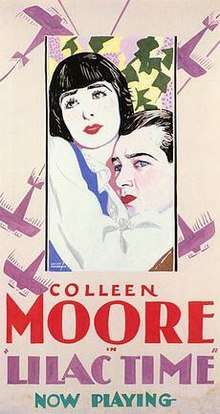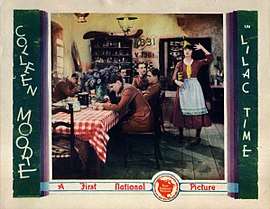Lilac Time (1928 film)
| Lilac Time | |
|---|---|
 Theatrical release poster | |
| Directed by |
|
| Produced by | John McCormick |
| Written by |
|
| Based on | play by Jane Murfin and Jane Cowl based on Lilac Time (novel) by Guy Fowler |
| Starring | Colleen Moore |
| Music by | |
| Cinematography | Sidney Hickox |
| Edited by | Alexander Hall |
Production company | |
| Distributed by | Warner Bros. |
Release date |
|
Running time | 110 minutes |
| Country | United States |
| Language |
English intertitles Vitaphone (music score and sound effects) |
Lilac Time is a 1928 American silent romantic war film directed by George Fitzmaurice and starring Colleen Moore and Gary Cooper. The film is about young American aviators fighting for Britain during World War I who are billeted in a field next to a farmhouse in France. The daughter who lives on the farm meets one of the new aviators who is attracted to her. As the flyers head off on a mission, the young aviator promises to return to her.[1][2]
Lilac Time was produced by John McCormick (Moore's husband), and distributed by First National Pictures. The film is based on a 1917 Broadway play written by Jane Murfin and actress Jane Cowl, who adapted the story from a novel by Guy Fowler.[3] This film was released with a Vitaphone score and music effects, featuring the song "Jeannine, I Dream of Lilac Time," but there was no spoken dialogue. The film premiered in New York City on August 3, 1928, and was released in the United States on October 18, 1928.
Plot
Seven young English aviators are billeted at the Berthelot farm near the French front. One of the flyers, Philip Blythe, falls in love with the farmer's daughter, Jeannie, who loves him, and on the morning before a dangerous mission declares his love for her.
Philip is shot down, and Jeannie helps an ambulance crew to extricate his apparently lifeless body from the wrecked plane. The crew will not allow Jeannie to accompany Philip and cannot tell her where they are taking him.
Jeannie obtains an address for the military army hospital where he is. When she visits, she is told that he has died from his wounds, based on incorrect records. Jeannie sends a bouquet of lilacs to his room in remembrance, and Philip, recognizing the flowers as her gift, painfully drags himself to his window in time to call her back to him.
Cast
- Colleen Moore as Jeannine Berthelot
- Gary Cooper as Captain Philip Blythe
- Burr McIntosh as General Blyth
- George Cooper as Mechanic's helper
- Cleve Moore as Captain Russell
- Kathryn McGuire as Lady Iris Rankin
- Eugenie Besserer as Madame Berthelot
- Émile Chautard as The Mayor
- Jack Stone as The Kid
- Edward Dillon as Mike the Mechanic
- Dick Grace as Aviator
- Stuart Knox as Aviator
- Harlan Hilton as Aviator
- Richard Jarvis as Aviator
- Jack Ponder as Aviator
- Dan Dowling as Aviator
- Eddie Clayton as The Enemy Ace
- Arthur Lake as The Unlucky One
- Philo McCullough as German Officer
- Nelson McDowell as French Drummer
Production

The film was shot on sets at First National's Burbank studio and on location in El Torro, California, where a working airstrip, full-sized French Village and farm were built. For some scenes, the deserted village in Allaire New Jersey were used for backdrops.[4] In addition a portable machine shop serviced the eight aircraft used in the production. Looking for realism, many extras cast as soldiers in the film had been actual World War I soldiers, in the ranks they portrayed. The chief stunt pilot, Dick Grace, had only finished doing stunt work on the Paramount film Wings almost two months earlier. Grace sustained a severe neck injury in a stunt crash while making Wings but recovered in time for Lilac Time.
The film offers several phases, beginning with slapstick comedy elements, becoming an intense romantic film, then segueing into a spectacular aerial showdown followed by a duel in the sky between Cooper's character and the Red Baron before returning to romantic complications.
Lilac Time had its opening in Los Angeles at the Carthay Circle Theatre where, in the lobby, among other promotional materials on display, was the wrecked fuselage of one of the aircraft that had been destroyed during the filming. The film cost one million dollars to produce, an amount equal to Moore's previous two films. The studio recouped the cost of the film within months. By the end of 1928, the film had out-performed Moore's earlier star vehicle Flaming Youth (1923).
Among those in the cast were Colleen Moore's brother Cleve (under the name Cleve Moore) and Jack Stone, her cousin. Eugenie Besserer had played "Mrs. Goode," a mother figure in Colleen's earlier film Little Orphant Annie, the first film to bring Colleen a measure of fame.[5]
A restored 35mm print of the film was screened at the Museum of Modern Art in New York City in September 2014.
Accolades
The film is recognized by American Film Institute in these lists:
- 2002: AFI's 100 Years...100 Passions – Nominated[6]
See also
References
Notes
- ↑ The AFI Catalog of Feature Films: Lilac Time
- ↑ The Library of Congress American Silent Feature Film Survival Catalog: Lilac Time
- ↑ Lilac Time produced on Broadway in 1917, from Internet Broadway Database
- ↑ Sitkus, Hance Morton, 2002, Images of America - Allaire, page 42
- ↑ Progressive Silent Film List: Lilac Time at silentera.com
- ↑ "AFI's 100 Years...100 Passions Nominees" (PDF). Retrieved 2016-08-19.
Bibliography
- Codori, Jeff (2012), Colleen Moore; A Biography of the Silent Film Star, McFarland Publishing Print ISBN 978-0-7864-4969-9 / EBook ISBN 978-0-7864-8899-5
External links
- Lilac Time on IMDb
- Synopsis at AllMovie
- Lilac Time at Virtual History
- Stills at silenthollywood.com
- Stills at silentfilmstillarchive.com